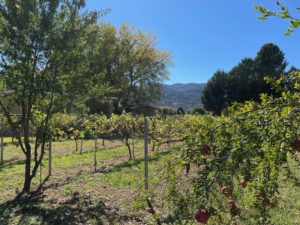“Definitely a reason to cheer for Verde Valley grape growers and winemakers,” Schumacher said.
According to the Treasury Department’s Tax and Trade Bureau, an AVA is a grape-growing region with geographic or climatic features that distinguish it from surrounding areas and affect how grapes are grown. Labeling local wines with the Verde Valley AVA designation certifies that the unique taste produced by the soils, grape growers and vintners of the region is found within every bottle.
Tom Schumacher of the Verde Valley Wine Consortium says AVA status is critical because “consumers often seek out wines from specific AVAs.” He added that Verde Valley wines will stand out in the marketplace, command higher prices and attract aficionados.
“Definitely a reason to cheer for Verde Valley grape growers and winemakers,” Schumacher said.
A critical reason for the Verde Valley’s success is reported to be the expertise of local winemakers in improving their art to reflect the Valley’s unique conditions. In addition, the Southwest Wine Center, an industry-scale model of a working farm/winery with a 13-acre sustainable vineyard at Yavapai College in Clarkdale, contributes with highly trained homegrown vintners and viticulturists. SWC graduates operate about a quarter of the area’s two dozen vineyards.
“The AVA designation is also excellent news for the ‘dispersal’ concept of sustainable tourism,” said Sedona Chamber of Commerce and Tourism Bureau President and CEO Candace Carr Strauss. “Dispersal means sending visitors to newer areas of interest to ease pressure on popular spots and balance economic impact.”
“The Verde Valley AVA can easily entice travelers to Sedona to try a completely different experience just a stone’s throw away,” she added. “The libations and hospitality of the popular Verde Valley Wine Trail and the Valley’s fertile landscape along Oak Creek and the Verde River can generate more overnight stays and spawn new attractions, making the ‘dispersal’ concept a reality.”
Verde Valley wine country also contributes to Sedona’s growing reputation for sustainability, with many wineries certified by the Arizona Sustainability Alliance.
At Clear Creek Winery in Camp Verde, herbs and peas reduce erosion and add nitrogen. Free-ranging chickens eat insects, domestic geese chew up weeds, and two Great Pyrenees dogs keep raccoons at bay. Page Springs Cellars vineyards in Cornville are no-till, meaning they don’t disturb the soil which releases carbon. Solar panels produce 75% to 85% of the electricity and wastewater runs through biological filters to an artificial wetland, supporting local flora.
AVA status is the second time in recent months Verde Valley wines have been in the national spotlight. In August, the Valley was named a “Top Ten Winegrowing Region” in the USA Today Readers’ Choice poll.
The U.S. Treasury Department says there are 260 established AVAs in the United States. Arizona has three. The Verde Valley is the only one in the North-Central region; the Willcox and Sonoita Valley AVAs are in Southern Arizona. FBN





